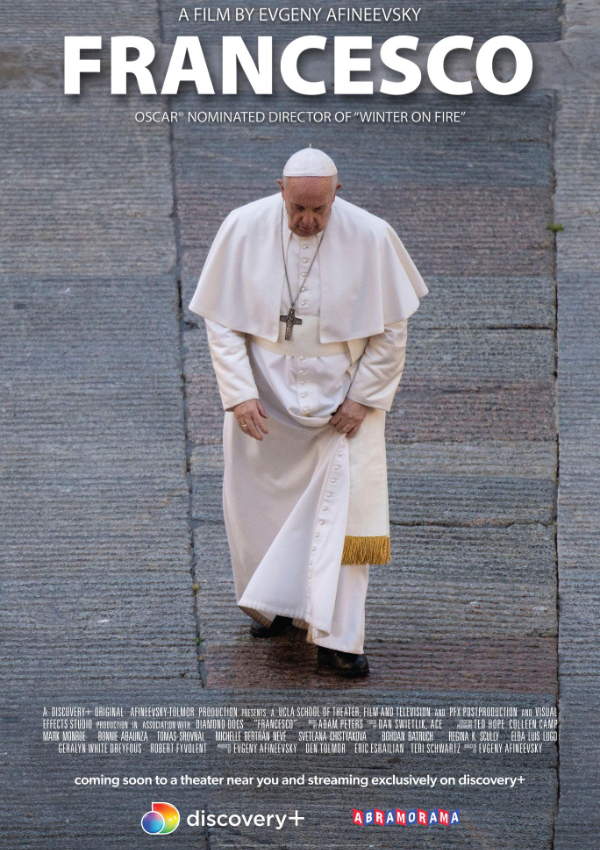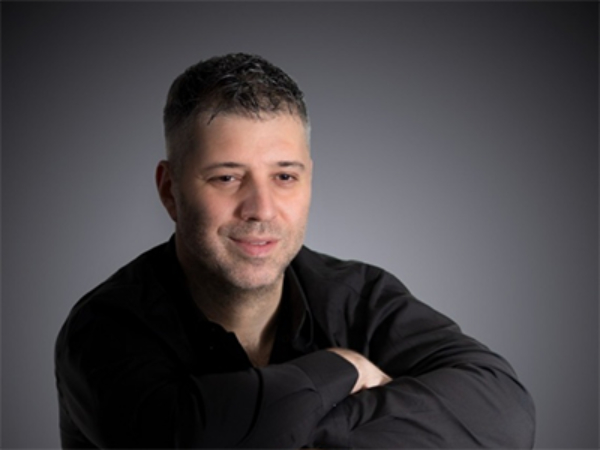Even though I'm a “media nun,” I'm not a big movie person. (It's a sensory overload thing.) Still, I follow events in the world of cinema, read movie reviews (“film critiques”), and try to apply basic media literacy approaches to the movies and TV shows that I do choose to watch. (That last is a skill I think we all need to keep practiced in!)
This week, I did watch a movie. The documentary Francesco premiered at the Rome Film Festival last fall and became available worldwide via streaming as of Palm Sunday. Clocking in at 1 hour 56 minutes, it's a beautiful film, but a bit overly long. (I had to watch it in two sittings.) The film could be seen as a presentation of the Pope's attempts over his (so far) eight year pontificate to emphasize the fundamental importance of the human person as such, prescinding anything a particular individual may have done or might be able to offer the world.
“I am not a religious person,” director Evgeny Afineevsky said. “And my movie is not about the Catholic Church. It’s about a man who leads an important institution, it’s about understanding, faith, and something much bigger than the Church.”

Juan Carlos Cruz meets Pope Francis / Courtesy Francesco Docet Production. Francesco Docet Production.
Afineevsky recognizes that Pope Francis pays remarkable attention to people. If the Pope draws attention to “issues,” it is not to draw converts to an ideology, but to show the living human beings whose lives and well-being are at risk—often because of the political, financial, or ideological interests of the powerful. The director may not quite get it, but the human person is central for Pope Francis, because the human person is central for God as “the only creature on earth which God willed for itself” (Vatican II: Gaudium et Spes, 24).
This is why Pope Francis keeps finding ways to draw the world's attention to human dignity, human rights, and concrete human needs. One example of this that was powerfully brought out in the film was his 2017 trip to Myanmar, just three months after Rohingya villages in Myanmar began to be destroyed (by the military that has now taken murderous control of the country). Rohingya refugees (at least 600,000 of them) flooded Bangladesh. So immediately after leaving Myanmar, the Pope went to Bangladesh. In the film, a representative of the Sant'Egidio community explained that wherever the Pope goes, journalists go, “and then the world will see.” And indeed, testified one Muslim refugee: “Ever since he came to visit us, our lives have changed. All the NGO's [non-governmental organizations] from around the world come... For that, we pray a lot for Pope Francis.”
The film reminded me of some the places the Pope had been carrying out this ministry of pointing the world's attention to suffering: Syria, Armenia, the Philippines, Auschwitz... The director did not fail to direct our attention also to the suffering that was needlessly perpetuated within the Church herself. The sex abuse crisis, specifically in Chile, was covered through the story of Juan Carlos Cruz (see photo), victim of a notorious priest-abuser whose crimes had been covered up for decades. Pope Francis had believed that the accusations were slanderous and said so publicly. But when a Vatican investigator brought back over a thousand pages of evidence the Pope admitted his mistakes in judgment publicly and apologized to the abuse victims, one on one.

Photo courtesy of discovery+.
Some segments of the film could be fruitfully used to illustrate areas of Catholic Social Teachings, except for the Church's teachings surrounding marriage, which the director seems not to grasp at all. But then, how could he be expected to? St Paul says that the bond of husband and wife is “a great mystery bespeaking Christ and the Church” (see Ephesians 5:31-33). It is theology, not simply a social reality. Pope John Paul's Theology of the Body relates the mutual self-giving of the Trinity to the creation of human beings, man and woman, in the image of God. This makes marriage, as Pope John Paul said, a primordial sacrament: a first “outward expression of an interior mystery of grace,” the grace of God's own life which we are invited to participate in “on earth and in Heaven.” Don't go looking for that in Francesco. But realize that this is the deep mystery that the Church perceives whenever marriage and family life are the issue. As a visible expression of the Trinity, it is not a mystery that any of us can understand.
The clip that caused such a stir at the Rome Film Festival came just after the halfway point in the film. It began with a two minute story of a same-sex couple with three children. As the video shifts between family photos and scenes of the Pope at Mass, Andrea Rubera tells of going to the Pope's Mass at Santa Marta three years earlier and delivering a letter asking about religious formation for his children, then of a phone call from the Pope telling him to go ahead and bring the children to the parish. “He didn't mention which was his opinion about my family. Probably he's following the doctrine on this point,” Rubera notes. I would have let the story end right there, but Afineevsky needed to make a point, and here he did something a bit underhanded.
The video shifts definitively from the family to scenes at Mass and to Pope Francis in an office (we now know this was footage from a Mexican television interview). The Pope's words, in Spanish, seem to comment on the story we have just heard: "Homosexual people have the right to be in a family…. They are children of God and have a right to a family…. " In the original audio context, the Pope was pleading that homosexual sons and daughters not be cast out of their parents' homes, and (in a separate question) referring to a civil union law proposed in Argentina ten years earlier, which he supported (as an alternative same-sex marriage). But the way the Pope's phrases were cut and moved around, and even more the way these 18 seconds of audio were placed after a full two-minute story about a particular gay couple gives the impression that this was the kind of family people “have a right to.” That is misleading. The Pope was clearly speaking about a gay person's family of origin. That in the source interview Pope Francis explicitly (and in rather brutal terms) ruled out “homosexual marriage” made it very clear what he intended. I wrote at length about this matter in November, and created a graphic that shows the Pope's original words and how they were cut and repositioned in Francesco.

Evgeny Afineevsky, director of "Francesco." © 2021 courtesy of Discovery+. All Rights Reserved.
Given that one of Pope Francis' hallmarks that of welcoming people with whom he disagrees on certain, sometimes fundamental, matters, I was disappointed that the director chose to be so disrespectful of the Pope as to alter the context and even the ordering of his words. If anything, the director could have had people acknowledge their perplexity that Francis continues to affirm age-old Church teachings on marriage and the family while being so genuinely open to people whose lives do not mirror the Catholic ideal (but seriously: whose life does?).
As long as it is, Francesco is certainly not a complete look at the Pope's defense of human life and dignity. There is nothing about unborn life, no defense of disabled persons, the terminally ill, the elderly; no mention of the striking condemnation of the “throwaway culture,” an expression with which the Pope indicts all callous disregard of human dignity (including the degradation of the environment). Well, Afineevsky is a filmmaker, not a catechist. Francesco is a beautiful film. It is stunningly produced, moving in its message. Watch it, but don't be lazy about it.
Know your own prejudices, expectations, and sacred cows. Are you “looking for trouble”? Just...don't.
If there's anything that strikes you as weird, out of place, illogical, a non-sequitur, or an editorial imposition, hit the pause button. Note the time stamp and a few key words, including the place or year of the setting. Later you can look for the original context of a remark, or for the occasion on which it was given (what was going on then and there?). You can easily find transcripts of the Pope's talks from his trips on the Vatican website to get the full context for the snippets that are included in the film.
In some parts of the movie, the Pope's voice switches from Italian (the language he uses in most formal occasions) to Spanish. That's a signal that the source has changed, too. That means that the English subtitles do not really follow one from the other in the Pope's thought. They are edited to flow in that order. Can you find the original context? If the Spanish language remarks include video footage of the Pope in a room with dark gold wallpaper, it is probably from a 2019 interview with Valentina Alazraki (Televisa, Mexico). (A partial transcript from that interview is available online in Spanish.)
Unpack the Pope's original talks and homilies for yourself. Pray with them. Study them! Use the film for enrichment, but don't make it your primary source for understanding Pope Francis. The film is Afineevsky's vision, and he is not a believer. He does not realize something that you and I and Pope Francis have been given to understand: that, unique in all the cosmos, people are the living image and likeness of God. Even more, that each and every person is someone for whom Jesus, God Incarnate, willingly gave his life.
In each and every person, Pope Francis sees Jesus, really sees him. Christ emptied himself and made our human nature his own, “For by His incarnation the Son of God has united Himself in some fashion with every man” (Vatican II: Gaudium et Spes, 22).
And that's the mystery we are entering into in the deepest way possible during the Sacred Triduum and Easter Season.
Sr Anne Flanagan writes on her "Nun Blog" and occasionally contributes here. Check out her social media presence on Twitter as @nunblogger.